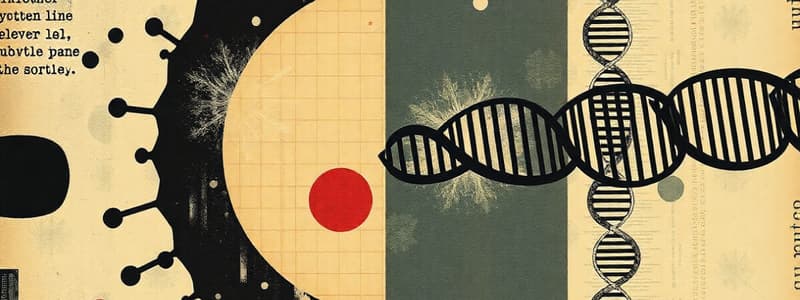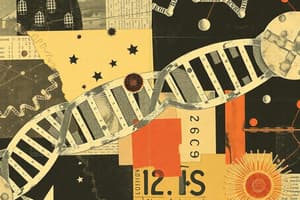Podcast
Questions and Answers
Which organelle is responsible for synthesizing lipids?
Which organelle is responsible for synthesizing lipids?
- Mitochondria
- Smooth Endoplasmic Reticulum (sER) (correct)
- Rough Endoplasmic Reticulum (rER)
- Nucleolus
Where do proteins undergo modifications after synthesis?
Where do proteins undergo modifications after synthesis?
- Nucleolus
- Golgi Apparatus (GA) (correct)
- Free Ribosomes
- Peroxisome
Which structure is known for participating in the formation of vesicles?
Which structure is known for participating in the formation of vesicles?
- Clathrin (correct)
- Lipase
- Synthetase
- Actin
Which enzyme is associated with ATP synthesis?
Which enzyme is associated with ATP synthesis?
What is the monomer of DNA?
What is the monomer of DNA?
Which bond is responsible for ensuring the primary structure of proteins?
Which bond is responsible for ensuring the primary structure of proteins?
What defines the secondary structure of a protein?
What defines the secondary structure of a protein?
Which type of bond contributes to the stability of the quaternary structure of proteins?
Which type of bond contributes to the stability of the quaternary structure of proteins?
What is the primary structure of DNA composed of?
What is the primary structure of DNA composed of?
Which term describes the secondary structure of DNA?
Which term describes the secondary structure of DNA?
What is an example of a protein exhibiting quaternary structure?
What is an example of a protein exhibiting quaternary structure?
Which bond type is critical for the secondary structural features of DNA?
Which bond type is critical for the secondary structural features of DNA?
What mechanism describes the third level of DNA packaging, involving interactions with scaffolds?
What mechanism describes the third level of DNA packaging, involving interactions with scaffolds?
Which interaction is essential for histone function in DNA packaging?
Which interaction is essential for histone function in DNA packaging?
What type of bond is primarily responsible for linking nucleotides in a polynucleotide chain?
What type of bond is primarily responsible for linking nucleotides in a polynucleotide chain?
Which nitrogenous base is absent from RNA but present in DNA?
Which nitrogenous base is absent from RNA but present in DNA?
Which protein is synthesized on ribosomes of the rough endoplasmic reticulum (rER)?
Which protein is synthesized on ribosomes of the rough endoplasmic reticulum (rER)?
Which organelle is known for having an acidic pH of around 5?
Which organelle is known for having an acidic pH of around 5?
Which bonds connect the two strands of DNA in a double helix?
Which bonds connect the two strands of DNA in a double helix?
Which of the following proteins undergoes modification in the Golgi apparatus?
Which of the following proteins undergoes modification in the Golgi apparatus?
How many hydrogen bonds are formed between Guanine and Cytosine?
How many hydrogen bonds are formed between Guanine and Cytosine?
Flashcards
Primary Protein Structure
Primary Protein Structure
The linear sequence of amino acids in a polypeptide chain, held together by peptide bonds.
Secondary Protein Structure
Secondary Protein Structure
The local folding of the polypeptide chain into alpha helices and beta sheets, stabilized by hydrogen bonds.
Quaternary Protein Structure
Quaternary Protein Structure
The arrangement of multiple polypeptide chains (subunits) in a protein complex, stabilized by various bonds including hydrogen, ionic, hydrophobic, and Van der Waals interactions.
Primary DNA Structure
Primary DNA Structure
Signup and view all the flashcards
Secondary DNA Structure
Secondary DNA Structure
Signup and view all the flashcards
DNA Packaging: Solenoid Level
DNA Packaging: Solenoid Level
Signup and view all the flashcards
DNA Packaging: Loops (SAR/MAR)
DNA Packaging: Loops (SAR/MAR)
Signup and view all the flashcards
DNP vs. RNP
DNP vs. RNP
Signup and view all the flashcards
Isomerase
Isomerase
Signup and view all the flashcards
Cardiolipn
Cardiolipn
Signup and view all the flashcards
Where are synthesized proteins?
Where are synthesized proteins?
Signup and view all the flashcards
Where are modified proteins?
Where are modified proteins?
Signup and view all the flashcards
Ribophorin
Ribophorin
Signup and view all the flashcards
Nucleosome Formation
Nucleosome Formation
Signup and view all the flashcards
H1 Histone Function
H1 Histone Function
Signup and view all the flashcards
DNA Base Pairing
DNA Base Pairing
Signup and view all the flashcards
RNA vs. DNA
RNA vs. DNA
Signup and view all the flashcards
Phosphodiester Bonds
Phosphodiester Bonds
Signup and view all the flashcards
rER Function
rER Function
Signup and view all the flashcards
GA Function
GA Function
Signup and view all the flashcards
Free Ribosomes vs. rER Ribosomes
Free Ribosomes vs. rER Ribosomes
Signup and view all the flashcards
Study Notes
Protein Structure
- Primary Structure: Defined by the sequence of amino acids linked by peptide bonds.
- Secondary Structure: Hydrogen bonds form alpha-helices or beta-sheets, influencing the protein's 3D shape.
- Tertiary Structure: Interactions between amino acid side chains (hydrophobic, hydrogen, ionic, disulfide bonds), resulting in a complex 3D structure.
- Quaternary Structure: Multiple polypeptide chains interact, leading to a multi-subunit structure. Interactions include hydrogen bonds, ionic bonds, and hydrophobic interactions.
Nucleic Acid Structure
- Primary Structure (DNA): The polynucleotide chain is formed by phosphodiester bonds between nucleotides.
- Secondary Structure (DNA): The double helix structure is stabilized by hydrogen bonds between complementary base pairs (Adenine with Thymine, Guanine with Cytosine).
- Tertiary Structure (DNA): Higher-order DNA structures form in response to interaction with proteins.
Cellular Processes
-
Ribosomes: Synthesize proteins (free ribosomes synthesize proteins for the cytosol, while rough endoplasmic reticulum (RER) bound ribosomes synthesize proteins for secretion or insertion into the cell membrane).
-
Golgi Apparatus (GA): Modifies, sorts, and packages proteins and lipids.
-
Lysosomes: Contain digestive enzymes, participate in the destruction of unwanted molecules.
-
Mitochondria: Energy production (ATP synthesis) and some lipid synthesis.
-
Endoplasmic Reticulum (ER): Synthesizes and modifies lipids and proteins, particularly those for external use or membrane insertion.
-
Nucleus: Contains the cell's genetic material (DNA), plays a vital role in cellular processes, including the formation of ribosomes.
-
Free Ribosomes: Synthesize proteins that function within the cytosol.
-
Bound Ribosomes: Synthesize proteins destined for secretion, insertion into membranes, or lysosomes.
-
Protein Modification: Post-translational modifications occur within various cellular compartments, such as the Golgi apparatus, influencing protein structure and function.
-
Cellular Transport: Active transport mechanisms, such as the Na+/K+ pump, move substances against their concentration gradient, requiring energy. Passive transport, such as osmosis or facilitated diffusion, moves substances down their concentration gradients, without requiring energy input.
-
DNA Replication: A process for producing two identical DNA molecules from one original.
-
Transcription: A process for producing a single-stranded RNA molecule from a double-stranded DNA template.
-
Translation: A process for building a protein from an mRNA template.
-
Detoxification: The process by which substances harmful to life are made harmless. This process may occur in different cellular compartments, such as the smooth ER.
Chemical Compounds
-
Nucleotides: The basic building blocks of DNA and RNA, composed of a nitrogenous base, a sugar, and a phosphate group. Examples: Adenine, Guanine, Cytosine, Thymine, Uracil.
-
Amino Acids: The fundamental units of proteins, consisting of an amino group, a carboxyl group, and a variable side chain.
-
Hydrogen Bonding: The attraction between a hydrogen atom covalently bonded to a highly electronegative atom (e.g., oxygen or nitrogen) and another electronegative atom.
Studying That Suits You
Use AI to generate personalized quizzes and flashcards to suit your learning preferences.




